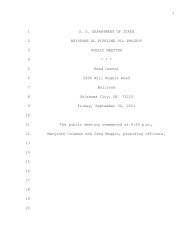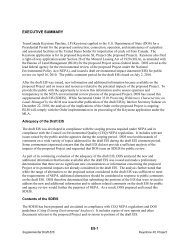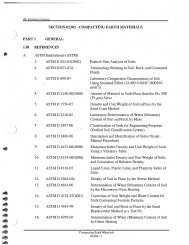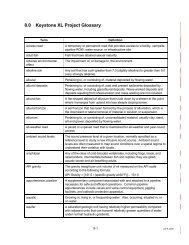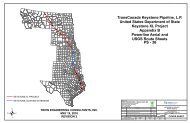2.1 Overview of the Proposed Project - Keystone XL pipeline - US ...
2.1 Overview of the Proposed Project - Keystone XL pipeline - US ...
2.1 Overview of the Proposed Project - Keystone XL pipeline - US ...
You also want an ePaper? Increase the reach of your titles
YUMPU automatically turns print PDFs into web optimized ePapers that Google loves.
Draft Supplemental Environmental Impact Statement<strong>Keystone</strong> <strong>XL</strong> <strong>Project</strong>Pipeline Construction SequenceFigure <strong>2.1</strong>.7-2 shows a typical <strong>pipeline</strong> construction sequence. The design and construction <strong>of</strong><strong>the</strong> <strong>pipeline</strong> would incorporate each <strong>of</strong> <strong>the</strong>se steps. Additionally, <strong>the</strong> proposed <strong>Project</strong> wouldinclude additional construction for access roads, construction work camps, and temporaryworkspace facilities. All aspects <strong>of</strong> proposed <strong>Project</strong> construction are addressed in <strong>the</strong> remainingsections <strong>of</strong> this section.Standard <strong>pipeline</strong> construction is composed <strong>of</strong> specific activities, including survey and staking <strong>of</strong><strong>the</strong> ROW, clearing and grading, pipe stringing, bending, trenching, welding, lowering in,backfilling, hydrostatic testing, and cleanup. In addition to standard <strong>pipeline</strong> constructionmethods, special construction techniques would be used where warranted by site-specificconditions. These special techniques would be used when constructing across rugged terrain,sensitive areas, waterbodies, wetlands, paved roads, highways, and railroads (see Section <strong>2.1</strong>.8,Special Pipeline Construction Procedures).Construction would be planned to continue into <strong>the</strong> early winter months for as long as possiblewithout <strong>the</strong> use <strong>of</strong> special winter construction techniques. However, as stated in <strong>the</strong> CMRP(Appendix G), if <strong>the</strong> proposed <strong>Project</strong> is authorized and winter construction is necessary to meetconstruction deadlines, <strong>Keystone</strong> would consult with <strong>the</strong> relevant federal, state, and localregulatory agencies to determine what changes may be necessary in permits issued, whatadditional permits may be required, and to identify <strong>the</strong> procedures that would have to beincorporated into construction to avoid or minimize environmental impacts. Winter constructionplans would be finalized based on those consultations and permit requirements. Normalconstruction activities would be conducted during daylight hours, with <strong>the</strong> following exceptions:• Completion <strong>of</strong> critical tie-ins on <strong>the</strong> ROW may occur after daylight hours. Completionrequires tie-in welds, non-destructive testing, and sufficient backfill to stabilize <strong>the</strong> ditch.• HDD operations may be conducted after daylight hours, if determined by <strong>the</strong> contractor to benecessary to complete a certain location. In some cases, that work may be requiredcontinuously until <strong>the</strong> work is completed; this may last 24 continuous hours or longer. Suchoperations may include drilling and pull-back operation, depending upon <strong>the</strong> site and wea<strong>the</strong>rconditions, permit requirements, schedule, crew availability, and o<strong>the</strong>r factors. Prior toconstruction, <strong>the</strong> presence <strong>of</strong> residences in proximity to <strong>the</strong> proposed HDD activities wouldbe determined. HDD activities would be conducted consistent with any applicable local noiseordinances.• Hydrostatic testing operations may be conducted after daylight hours if determined by <strong>the</strong>contractor to be necessary to complete a certain location. In some cases, that work may berequired continuously until <strong>the</strong> work is completed; this activity may take place for 24continuous hours or longer.• While not anticipated in typical operations, certain work may be required after <strong>the</strong> end <strong>of</strong>daylight hours due to wea<strong>the</strong>r conditions, for safety, or for o<strong>the</strong>r proposed <strong>Project</strong>requirements.<strong>Project</strong> Description <strong>2.1</strong>-40 March 2013



